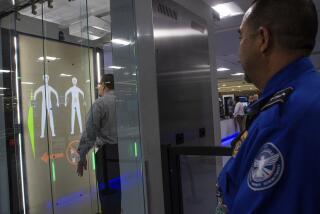Bomb ‘Sniffer’ Will Be Tested at S.F. Airport
- Share via
WASHINGTON — A new bomb detector that chemically “sniffs out” explosives will be tested for a month this spring at San Francisco International Airport, the Federal Aviation Administration announced Saturday.
“We will be field testing to see how the equipment performs in the real world,” said Stephen D. Hayes, assistant administrator for public affairs at the FAA.
He added that if the tests are successful, they will be repeated at other major airports. Ultimately, baggage-checking and personal screening could be speeded up nationwide.
Takes Six Seconds
The new device is able to examine a piece of luggage in six seconds, a considerably shorter time than it now takes to check baggage by hand for explosives.
The contractor for the equipment is Science Applications International Corp. of Sunnyvale, Calif.
Robert J. Schneider, airport duty manager at the San Francisco airport, called the new equipment a “state-of-the-art” device, a “sniffer type that depends on chemical reaction” designed to detect nitrogen, an element in all known explosives, some of which cannot be spotted by X-rays.
“Because nitrogen also is present in other materials, the system must determine its intensity and concentration to find explosives,” said Tsahi Gozani, corporate vice president and chief scientist at Science Applications.
In the new technology, pieces of luggage and cargo pass through a chamber on a conveyor belt on their way to the cargo holds of airliners. As they do, they are bombarded with neutrons, which interact with nitrogen.
A computer then analyzes the energy data produced by the interaction and alerts officials to the presence of hazardous amounts of nitrogen, allowing them to pull the luggage or cargo. The procedure cannot be used to detect passengers hiding explosives on their persons because bombarding passengers with neutrons would be hazardous. The FAA is looking for other ways of screening passengers for explosives and weapons.
Vapor Detector Sought
In addition to improved X-ray devices, the FAA is interested in a detector that can analyze and isolate vapors that surround people and explosives, even including plastic explosives.
The State Department already is using the vapor-detection system in several embassies, according to officials at the firm that developed it, Thermedics Inc., of Woburn, Mass.
John W. Wood Jr., president of Thermedics, said in a telephone interview that a prototype is being developed for use at airports and would be delivered to the FAA in mid-1988. He likened the technology to a “mechanized dog” that can detect explosive vapors but never gets tired and does not have to be fed.
Wood said that older technology was ineffective at airports because it often confused the chemicals in explosives with “chemical relatives” found in other products, including perfumes, household solvents and shoe polish. “They gave false alarms and, for that reason, were never widely used,” he said.
Blending of Technologies
Wood called the system made by his firm and the one developed by the California company “complementary technologies” that, together, would improve screening of both cargo and passengers.
The new technologies are the latest elements in the broad approach to airport security that the federal government believes is necessary to combat terrorism.
Other components include intelligence-gathering, intensified training of security personnel and tighter identification requirements for workers who have access to planes.
To be successful at thwarting airline bombers, Hayes said: “We need to develop a variety of things simultaneously. We continue to move ahead on a number of fronts.” He added that “the track record of aviation security has been excellent within the United States.”
Recently, would-be bombers and weapons-toting hijackers have concentrated on flights originating in foreign cities. But they still remain a threat to U.S. airports, because planes carrying bombs could land in this country, he said.
Schneider, of the San Francisco airport, said that the bomb-detector tests will be conducted on “live, outbound flights” headed for other countries.
Has Best Safety Record
He said the airport was selected for the tests because it has had the best safety record in the nation for the last seven years in areas including crashes, fire rescue and medical preparedness and because it is a coastal gateway for overseas flights.
The tests will come during peak use of the airport, which is anticipating as many as 1,500 arrivals and departures a day. That figure is up from 1,340 last year, Schneider said.
“We are delighted to test out the new equipment because we are always trying to improve safety,” he said.
More to Read
Sign up for Essential California
The most important California stories and recommendations in your inbox every morning.
You may occasionally receive promotional content from the Los Angeles Times.










